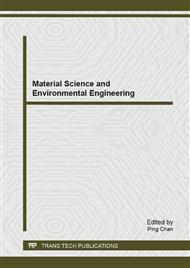[1]
M. Magot, B. Ollivier, and B.K.C. Patel, Microbiology of petroleum reservoir, Anton. Van. Lee. 77 (2000) 103-116.
Google Scholar
[2]
J.D. Van Hamme, A. Singh, and O.P. Ward, Recent adcances in petroleum microbiology, Microbiol. Mol. Biol. Rev. 67 (2003) 503-549.
DOI: 10.1128/mmbr.67.4.503-549.2003
Google Scholar
[3]
C.M. Aitken, D.M. Jones, and S.R. Larter, Anaerobic hydrocarbon biodegradation in deep subsurface oil reservoirs, Nature. 431 (2004) 291-294.
DOI: 10.1038/nature02922
Google Scholar
[4]
J.C. Philp, A.S. Whiteley, L. Ciric, M.J. Bailey, Monitoring bioremediation, in R.M. Atlas and J.C. Philp (Eds), Bioremediation: Applied Microbial Solutions for Real-World Environmental Cleanup, ASM Press., Washington, DC, USA, 2005, pp.237-268.
DOI: 10.1128/9781555817596.ch6
Google Scholar
[5]
V.M. Oliveira, L.D. Sette, K.C.M. Simioni, E.V. doa Santos Neto, Bacterial diversity characterization in petroleum samples from Brazilian reservoirs, Braz. J. Microbiol. 39 (2008) 445-452.
DOI: 10.1590/s1517-83822008000300007
Google Scholar
[6]
I. von der Weid, E. Korenblum, D. Jurelevicius, et al. Molecular diversity of bacterial communities from subseafloor rock samples in a deep-water production basin in Brazil, J. Microbiol. Biotechnol. 18 (2008) 5-14.
Google Scholar
[7]
E. Korenblum, E. Valoni, M. Penna, L. Seldin, Bacterial diversity in water injection systems of Brazilian offshore oil platforms, Appl. Microbiol. Biotechnol. 85 (2010) 791-800.
DOI: 10.1007/s00253-009-2281-4
Google Scholar
[8]
G. Muyzer and A.J.M. Stams, The ecology and biotechnology of Sulphate-reducing bacteria, Nat. Rev. Microbiol. 6 (2008) 441-454.
DOI: 10.1038/nrmicro1892
Google Scholar
[9]
S.M. Keith, R.A. Herbert, C.G. Harfoot, Isolation of new types of Sulphate-reducing bacteria from estuarine and marine sediments using chemostat enrichments, J. Appl. Bacteriol. 53 (1982) 29-33.
DOI: 10.1111/j.1365-2672.1982.tb04731.x
Google Scholar
[10]
R.J. Parkes, G.R. Gibson, I. Mueller-Harvey, W.J. Buckingham, R. Herbert, Determination of the substrates for Sulphate-reducing bacteria within marine and estuarine sediments with different rates of Sulphate reduction, J. Gen. Microbiol. 135 (1989).
DOI: 10.1099/00221287-135-1-175
Google Scholar
[11]
F. Bak and N. Pfennig, Sulfate-reducing bacteria in littoral sediment of Lake Constance, FEMS Microbiol. Ecol. 85 (1991) 43-52.
DOI: 10.1111/j.1574-6968.1991.tb04696.x
Google Scholar
[12]
P. Caumette, Ecology and physiology of phototrophic bacteria and Sulphate-reducing bacteria in marine salterns, Experientia. 49 (1993) 473-481.
DOI: 10.1007/bf01955148
Google Scholar
[13]
J.R. Postgate, The Sulphate-Reducing Bacteria, Cambridge U. Press. London (1984).
Google Scholar
[14]
F. Widdel, and N. Pfennig, Bergey's Manual of Systematic Bacteriology, Williams & Wilkins, Baltimore 1 (1984) 663-679.
Google Scholar
[15]
R. Cord-Ruwisch, W. Kleinitz, and F. Widdel, Sulfate-Reducing Bacteria and Their Activities in Oil Production, J. Pet. Technol. 39 (1987) 97-106.
DOI: 10.2118/13554-pa
Google Scholar
[16]
V.D.W. Irene, E. Korenblum, D. Jurelevicius, A.S. Rosado, R. Dino, G.V. Sebastian, L. Seldin, Molecular diversity of bacterial communities from subseafloor rock samples in a deep-water production basin in Broazil, J. Microbiol. Biotechnol. 18 (2008).
Google Scholar
[17]
D.J. Lane, 16S/23S rRNA sequencing, In: Stackebrandt E, Goodfellow M (Eds. ), Nucleic acids techniques in Bacterial systematics, John Wiley & Sons, Chichester, 1991, pp.115-147.
Google Scholar
[18]
H. Heuer, M. Krsek, P. Baker, K. Smalla, E.M. Wellington, Analysis of actinomycete communities by specific amplification of genes encoding 16S rRNA and gel-electrophoretic separation in denaturing gradients, Appl. Environ. Microbiol. 63 (1997).
DOI: 10.1128/aem.63.8.3233-3241.1997
Google Scholar
[19]
M. Zaballos, A. Lopez-Lopez, L. Ovreas, et al. Comparison of prokaryotic diversity at offshore oceanic locations reveals a different microbiota in the Mediterranean Sea, FEMS. Microbiol. Ecol. 56 (2006) 389-405.
DOI: 10.1111/j.1574-6941.2006.00060.x
Google Scholar
[20]
J.D. Thompson, T.J. Gibson, F. Plewniak, F. Jeanmougin, D.G. Higgins, The CLUSTAL X windows interface: flexible strategies for multiple sequence alignment aided by quality analysis tools, Nucleic. Acids. Research. 25 (1997) 4876-4882.
DOI: 10.1093/nar/25.24.4876
Google Scholar
[21]
R. Kondo, D.B. Nedwell, K.J. Purdy, S.Q. Silva, Detection and enumeration of Sulphate-reducing bacteria in estuarine sediments by competitive PCR, Geomicrobiol. J. 21 (2004) 145-157.
DOI: 10.1080/01490450490275307
Google Scholar
[22]
J. Leloup, A. Loy, N.J. Knob, C. Borowski, M. Wagner, B.B. Jorgensen, Diversity and abundance of sulfate-reducing microorganisms in the sulfate and methane zones of a marine sediment, Black Sea, Environ. Microbiol. 9 (2007) 131-142.
DOI: 10.1111/j.1462-2920.2006.01122.x
Google Scholar
[23]
L. Zhao, T. Ma, M. Gao, P. Gao, M. Gao, X. Zhu, G. Li, Characterization of microbial diversity and community in water flooding oil reservoirs in China, World. J. Microb. Biot. 28 (2012) 3039-3052.
DOI: 10.1007/s11274-012-1114-2
Google Scholar
[24]
K. Mori, H. Kim, T. Kakegawa, S. Hanada, A novel lineage of sulfate-reducing microorganisms: Thermodesulfobiaceae fam. Nov., Thermodesulfobiumnarugense, gen. nov., sp. Nov., a new thermophilic isolate from a hot spring, Exremophiles. 7 (2003).
DOI: 10.1007/s00792-003-0320-0
Google Scholar


